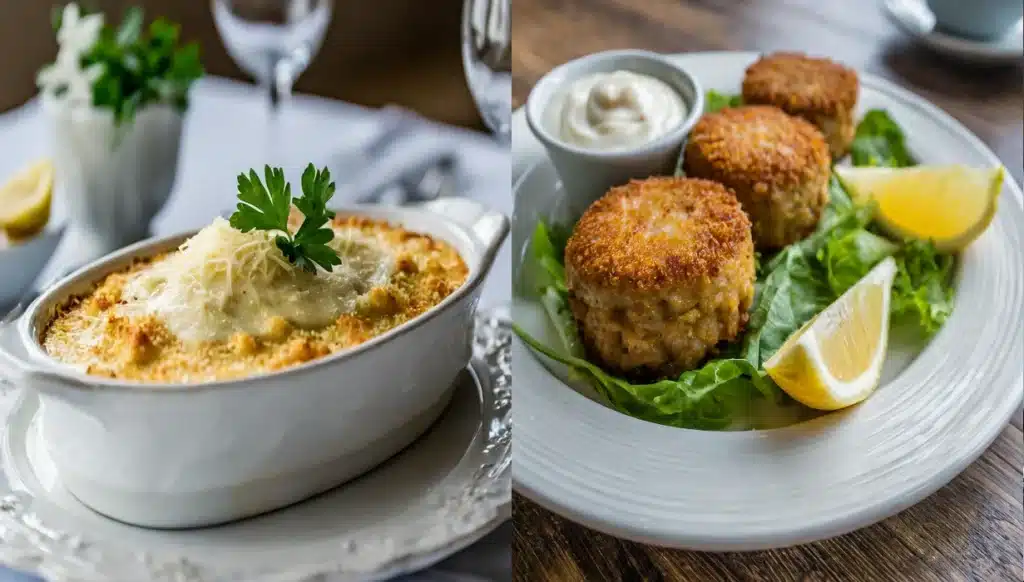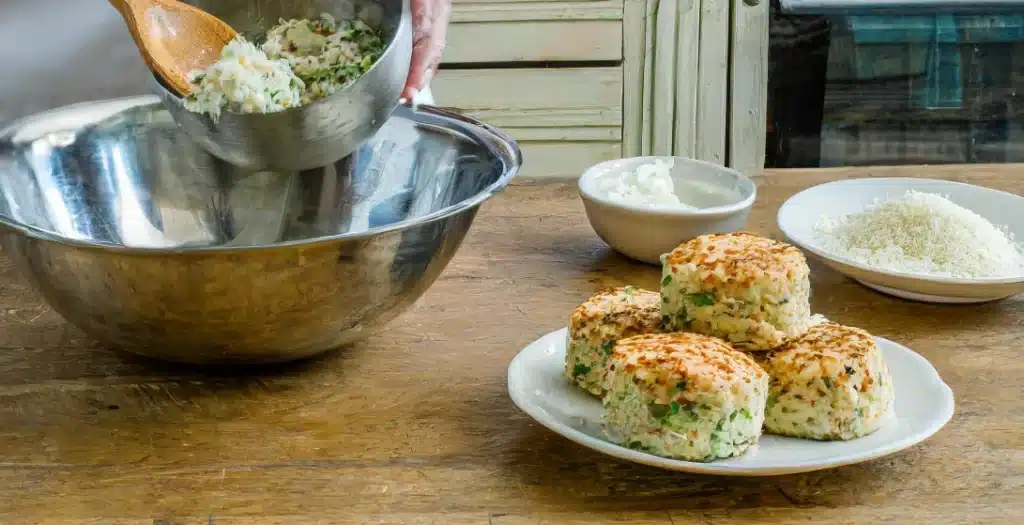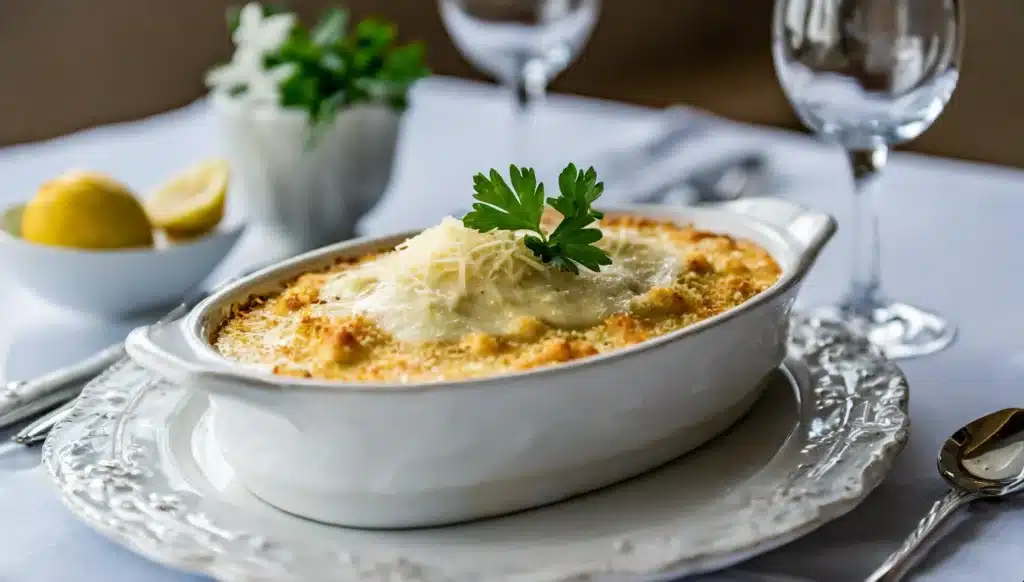
Introduction
What is the difference between crab cakes and crab imperial? This question piques the curiosity of many seafood lovers. Crab cakes and crab imperial are both cherished seafood dishes, each boasting a unique preparation and flavor profile that highlights the versatility of crab meat. These dishes not only hold significant positions in culinary traditions but also reflect the cultural heritage of the regions where they are popular.
What are Crab Cakes?
Crab cakes are a type of seafood patty, renowned for their crisp exterior and tender, flaky interior. Here’s what generally goes into making this beloved dish:
- Basic Description: A crab cake primarily features crab meat mixed with various ingredients and seasonings, then formed into patties and cooked to golden perfection.
- Historical Background: Originating from the Chesapeake Bay region, crab cakes have been an essential part of American seafood cuisine for decades.
- Common Ingredients and Variations:
- Crab meat (typically lump or backfin)
- Breadcrumbs or cracker meal
- Mayonnaise and eggs as binders
- Seasonings such as Old Bay, parsley, and mustard
For additional crab recipes, visit Daily Recipe Haven’s Branzino Crab Imperial Recipe.

What is Crab Imperial?
Crab Imperial offers a decadent twist on traditional crab dishes, characterized by its rich and creamy texture.
- Definition and Differences: Unlike crab cakes, crab imperial is a casserole-like dish, often served as a bake with a creamier texture due to the generous use of mayonnaise and sometimes cheese.
- Historical Origins: With roots also in the Chesapeake Bay area, this dish is a testament to the region’s love for rich and hearty seafood creations.
- Key Ingredients and Typical Presentation:
- Crab meat
- Mayonnaise as the primary binder
- Ingredients such as green peppers, pimentos, and onions for enhanced flavor
- Often topped with breadcrumbs or cheese before baking
Explore a detailed recipe on crab imperial at Daily Recipe Haven’s Crab Recipe.

Comparative Analysis
- Texture and Flavor Profiles: Crab cakes are known for their crispy exterior and tender meat inside, while crab imperial is softer and creamier.
- Preparation Methods and Culinary Uses:
- Crab Cakes: Typically pan-fried, broiled, or baked, served as main dishes or appetizers.
- Crab Imperial: Baked in a casserole dish, often used as a topping for other meats or seafood.
Nutritional Comparison
Comparing the nutritional content of these dishes:
- Caloric Content: Crab cakes might be higher in calories due to frying, whereas crab imperial is richer with the inclusion of mayonnaise.
- Nutritional Benefits and Potential Allergens:
- Both dishes are excellent sources of protein and essential nutrients but can be high in cholesterol and sodium.
For further details on the nutritional aspects of seafood, you might want to look at Seafood Health Facts: Making Smart Choices.
Cultural Significance and Regional Preferences
- Perceptions and Uses: In Maryland and the broader Chesapeake area, both dishes are staples at family gatherings and community celebrations.
- Special Occasions and Traditional Uses:
- Crab cakes are often a festive food, featured heavily at events and holiday meals.
- Crab imperial is considered a gourmet dish, reserved for more formal or high-end dining experiences.
Cooking Techniques
Both crab cakes and crab imperial boast their unique preparation methods, each requiring specific techniques for optimal flavor and texture.
- Step-by-Step Preparation of Crab Cakes:
- Combine crab meat with binding agents like eggs and mayonnaise.
- Add fillers such as breadcrumbs or crackers for consistency.
- Season with spices and herbs before forming into patties.
- Cook by frying, broiling, or baking until golden and crisp.
- How to Prepare Crab Imperial:
- Mix crab meat with a creamy binder, usually a rich mayonnaise mixture.
- Incorporate spices and optional additives like diced peppers or onions for flavor.
- Place in a baking dish, top with breadcrumbs or cheese, and bake until bubbly and golden.
- Tips for Achieving the Best Flavor and Texture:
- Use fresh, high-quality crab meat for both dishes to ensure the best taste.
- Do not overmix to keep the crab meat chunky and the texture pleasing.
For a detailed example of cooking crab imperial, check out Costas Inn’s Crab Imperial Recipe, which provides excellent guidance on creating this delightful dish.

Serving Suggestions
Properly serving these dishes can enhance the dining experience by complementing their flavors with appropriate sides and presentation.
- Ideal Side Dishes and Pairings:
- For Crab Cakes: Light salads, steamed vegetables, or a tangy remoulade sauce.
- For Crab Imperial: Creamy mashed potatoes, asparagus, or a crisp garden salad.
- How to Serve for Special Events:
- Consider mini crab cakes as appetizers for parties.
- Serve crab imperial in individual ramekins for an elegant presentation.
Learn more about suitable sides from what side dish goes with crab imperial.
FAQs
Here are some frequently asked questions about these popular crab dishes:
- What are the main differences in ingredients between crab cakes and crab imperial?
- Crab cakes often use less mayo and more fillers like breadcrumbs, while crab imperial is more mayo-rich and sometimes includes cheese.
- Can crab imperial be used as a filling for crab cakes?
- Absolutely, incorporating crab imperial as a filling can add a creamy texture to the cakes.
- What are some common mistakes when making crab cakes or crab imperial?
- Overmixing the crab meat, which can lead to dense and tough cakes, and underseasoning, which can make the dishes bland.
Home Cooking vs. Restaurant Style
Achieving restaurant-quality crab cakes and crab imperial at home can be accomplished with a few insider tips.
- Replicating Restaurant-Quality Dishes:
- Focus on the quality of ingredients, especially the freshness of the crab.
- Proper seasoning and careful cooking are key to achieving that professional taste and presentation.
- Techniques Used in Professional Kitchens:
- Chefs often use a gentle hand when mixing and forming crab cakes to maintain texture.
- Baking crab imperial at just the right temperature ensures it is creamy without being oily.
Future Trends and Innovations
The world of culinary arts continuously evolves, and crab dishes are no exception.
- New Variations and Modern Twists:
- Experimenting with gluten-free ingredients for crab cakes.
- Incorporating exotic spices into crab imperial for a global twist.
- Sustainability and Sourcing of Ingredients:
- The shift towards using sustainably sourced crab meat.
- Local sourcing of ingredients to support regional economies and reduce carbon footprint.
Conclusion
Crab cakes and crab imperial each offer a delightful taste of the sea, perfect for any occasion from casual family dinners to elegant festive gatherings. Exploring the differences between crab cakes and crab imperial not only enhances your culinary repertoire but also deepens appreciation for these versatile dishes. Whether you choose to whip up a batch of light and crispy crab cakes or indulge in the rich decadence of crab imperial, both dishes are sure to satisfy your seafood cravings.
For further exploration of crab dishes and their variations, take a look at what is crab imperial made of for a deep dive into the ingredients and culinary techniques that define this luxurious dish.
